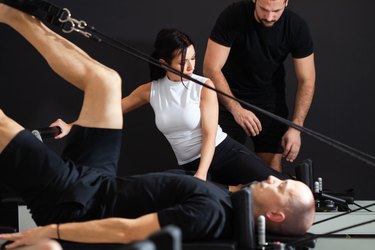
There are a lot of misconceptions about Pilates: that it's easy or that every class is the same. But Pilates is a challenging workout for both men and women with plenty of variety that you can adapt to any fitness level. Put simply: It'd be a mistake to not try Pilates at least once.
But it's so much more than a low-impact ab workout. Below, you'll learn how to get started on your first Pilates session, details on all its health benefits and exercises to target every major muscle group.
Video of the Day
Video of the Day
What is Pilates?
Don't be afraid to let yourself be a beginner. Everyone starts somewhere, and with Pilates, it's relatively easy to get going.
Pilates is generally a slower, more focused form of exercise, and much like in a yoga class, your instructor guides you through each exercise, one move to the next. That gives you plenty of time to focus on form without feeling like you're flying through your workout. Plus, it's low impact, so even those with joint issues can give it a try (however, if you have back injuries or are postpartum, it's best to consult a doctor).
Developed by Joseph Pilates in the early 20th century, this form of strength-building exercise involves slow, controlled motions that focus on developing core strength and total-body stability, according to the Cleveland Clinic.
Deep breathing is another key part of Pilates. Much like yoga, you move in sync with your breath in order to help tighten your core and get the most out of different motions and poses.
How Is Pilates Different Than Yoga?
Although they're both a low-impact form of Pilates, it's not exactly the same thing as a yoga class. While some of the poses may be similar, yoga usually involves holding different positions for longer periods of time, whereas Pilates has more consistent motion.
In Pilates, building strength and stability has a higher focus than in your average yoga class, too.
Benefits of Pilates
Yes, it's true that improved core strength is a major Pilates benefit. Throughout a class, your instructor may remind you to engage your powerhouse to initiate movement. In other words, expect to contract your abs the entire time.
But there are plenty of other reasons to give it a try. For starters, Pilates can help ease lower back pain, and it's a great cross-training workout, especially for runners and other athletes who rely on their core to power their performance, per the Cleveland Clinic.
And because it focuses so much on those core muscles, Pilates can even help improve your posture and overall body awareness.
Plus, you can do Pilates right at home! With at-home Pilates workouts, you don't even have to change out of your sweats (though exercise leggings and a workout tee will probably feel more comfortable). You also don't need much equipment — for most at-home classes, all you need is a mat.
So, just roll out your mat and try a few beginner-friendly at-home moves. (Unless you're lucky enough to have your very own Pilates reformer in your living room.)
Is Pilates a Good Way to Lose Weight?
Pilates, like all forms of strength-building exercise, is a great way to help promote weight loss. However, it's a lower-intensity workout, so it probably won't shed as many calories as other forms of movement, like high-intensity interval training. Nevertheless, incorporating Pilates is a great way to build strength and promote total-body fat loss.
Different Types of Pilates
Mat vs. reformer, Stott vs. Winsor: What's really the difference between all these types of Pilates — and does it actually matter? Though mat and reformer Pilates get most of the attention, there are several other options, which is great if you don't automatically love those first two.
- Classical Pilates: This is the original system created by Joseph Pilates, blending both mat and apparatus work. These workouts are structured and pretty consistent.
- Mat Pilates: This is a core-focused Pilates you can do right at home on a yoga mat.
- Reformer Pilates: This form is also core-focused, like mat workouts, but is performed on a reformer (a bed-like frame that's attached to springs, which change the resistance).
- Contemporary Pilates: Usually, you find this form in a studio class form where the instructor blends different types of Pilates.
- Stott Pilates: This form is focused on injury rehabilitation and safety in movement.
- Winsor Pilates: This Pilates is weight-loss focused and combines classical movements to maximize benefits.
No matter what kind of Pilates class you find yourself in, the workouts all rely on the core Pilates principles of breathing, control, centering, flow and precision.
Have nagging neck pain? Try Stott Pilates, which focuses on rehabilitation exercises. Looking to lose weight? Winsor Pilates combines 13 traditional Pilates exercises like the Hundred or Roll-Up into short, effective workouts that are different each session. If you want something new and different every time you walk into class, check out a contemporary Pilates class instead.
Getting Started With Pilates Workouts
Just like there's a type of Pilates for every sweat style, there's a Pilates workout targeting every major muscle group, too. Whether you want to accentuate your abs, build your butt or lengthen your legs, Pilates can help you reach your goal.
New to Pilates? This form of movement can be totally beginner-friendly — you just need to look for classes that cater to newbies in the studio. Or, search the web for some beginner Pilates workouts or videos, so you can try the modality right at home.
How Often Should a Beginner Go to Pilates?
Ease into the new form of exercise with a class or two per week and make sure to fuel properly and stay hydrated (yes, even if you're not sweating a ton). And if you're brand new, you may experience a little post-Pilates soreness, which is totally normal.